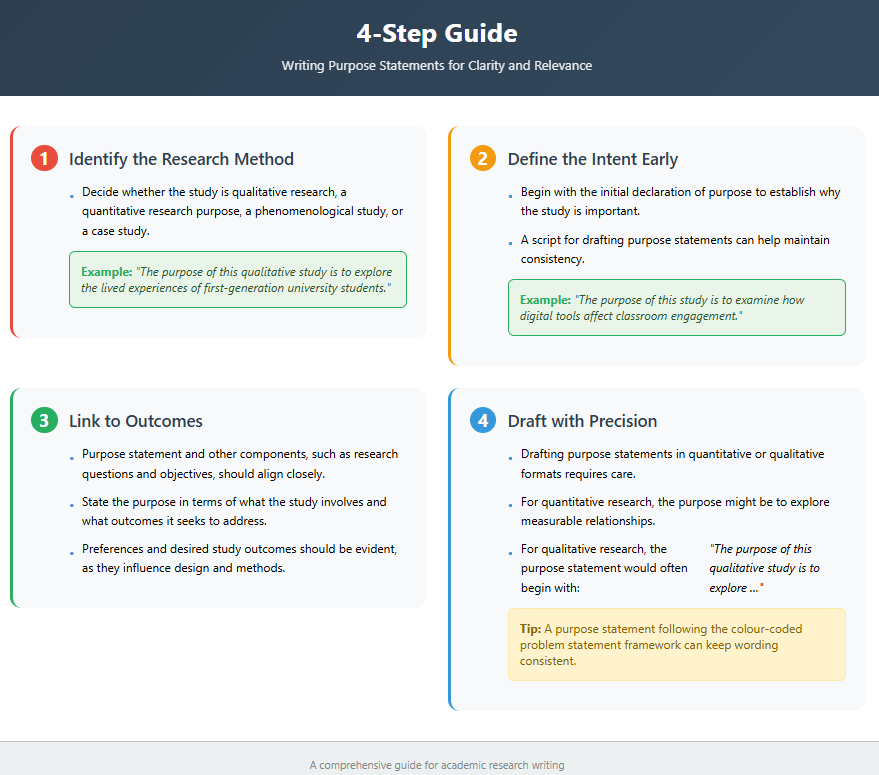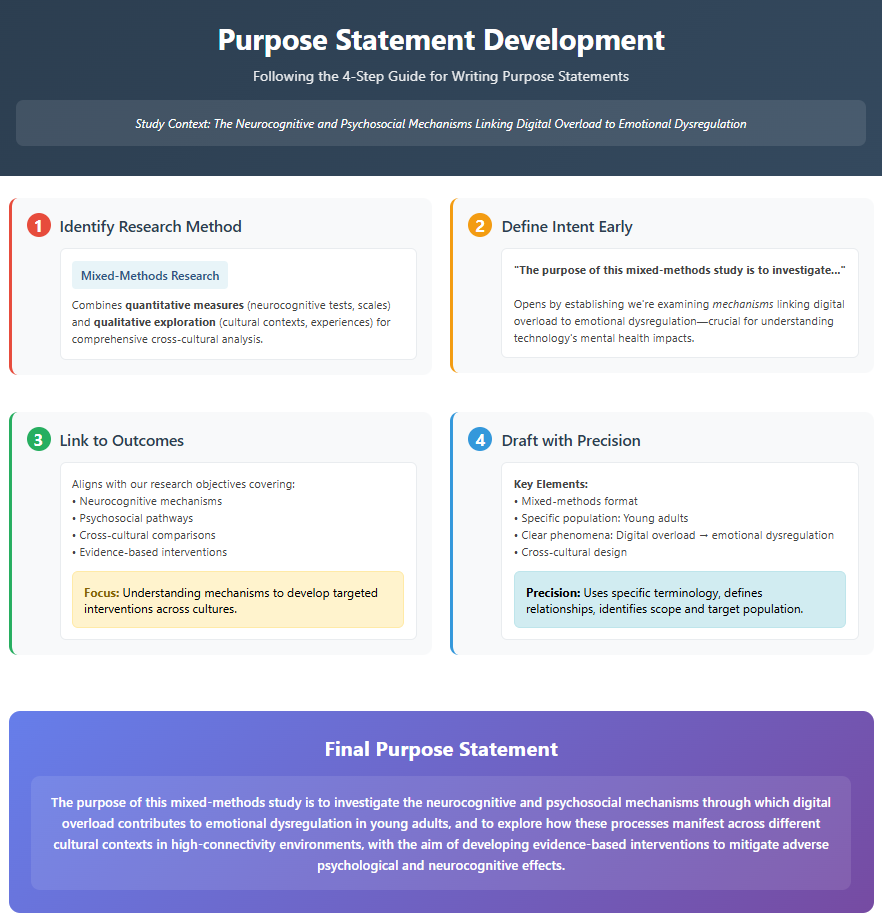Understanding the Purpose of the Study in a Dissertation
- Clarity of direction in a dissertation
- The purpose of the study acts as the guiding compass of your dissertation.
- It explains the reason for conducting the study, ensuring your research project stays focused.
- Without a clearly written purpose of the study statement, the research process may lack structure.
- Establishing research relevance
- The purpose of this study should link directly from the problem statement.
- It highlights the intent of the study and demonstrates the academic or practical value of the research.
- Defining scope and limitations
- Whether qualitative or quantitative, the purpose of the study section frames what will and will not be examined.
- It helps refine the research design, research methods, and the focus of your research.
- Contribution to knowledge
- The study’s purpose is to examine key concepts under study and show how they advance understanding in the chosen field.
- A well-defined purpose section reflects the research questions and ultimately provides coherence to the dissertation.
Elite Dissertation Services
Unlock academic success with Elite Thesis Help. Our professional dissertation writing services provide tailored support, from crafting research aims to perfecting your purpose of the study statement. Get started today!
Purpose Statement Overview and the Purpose of the Study Section
- What is a purpose statement?
- A purpose statement should focus on the central aim of the research project.
- It presents the research purpose in a single, concise form.
- Example: “The purpose of this qualitative study is to explore the lived experiences of nurses in palliative care.”
- Key functions of the purpose section
- Defines the goal of the study and research objective.
- Explains how the purpose of your study reflects the research questions.
- Clarifies whether you are dealing with a qualitative study, quantitative correlational study, phenomenological study, or case study.
- Developing the purpose
- Writing the purpose involves more than stating the research problem.
- The purpose statement should focus on measurable, researchable outcomes.
- In a quantitative purpose statement, the purpose of this quantitative study may be phrased as “to examine the correlation between digital literacy and academic success.”
- In qualitative research, a qualitative purpose often uses wording such as “the purpose of this qualitative study is to explore …”
- Sample purpose for clarity
- A sample purpose could read: “The purpose of this study is to examine the relationship between leadership styles and team productivity in small enterprises.”
- This reflects both the intent of the study and its connection to the problem statement and research questions.
Linking the Problem Statement and Purpose Statement
- Direct connection
- The problem statement and purpose statement must always be aligned.
- The research problem identifies what is wrong, while the purpose statement outlines what the research study will do about it.
- A strong link ensures the purpose of your research project stays relevant and actionable.
- Problem statement and research questions
- Research questions emerge directly from the problem statement.
- The purpose of your study should reflect those questions throughout the research process.
- For example, if the research problem relates to educational inequality, the purpose of this qualitative study may be to explore student perspectives on resource allocation.
- Why alignment matters
- Misalignment between the problem statement and purpose statement weakens the entire dissertation.
- Keeping the purpose of this study consistent with the research problem demonstrates academic rigour.

4-Step Guide in Writing Purpose Statements for Clarity and Relevance
- Identify the research method
- Decide whether the study is qualitative research, a quantitative research purpose, a phenomenological study, or a case study.
- Example: “The purpose of this qualitative study is to explore the lived experiences of first-generation university students.”
- Define the intent early
- Begin with the initial declaration of purpose to establish why the study is… important.
- Example: “The purpose of this study is to examine how digital tools affect classroom engagement.”
- A script for drafting purpose statements can help maintain consistency.
- Link to outcomes
- Purpose statement and other components, such as research questions and objectives, should align closely.
- State the purpose in terms of what the study involves and what outcomes it seeks to address.
- Preferences and desired study outcomes should be evident, as they influence design and methods.
- Draft with precision
- Drafting purpose statements in quantitative or qualitative formats requires care.
- For quantitative research, the purpose might be to explore measurable relationships.
- For qualitative research, the purpose statement would often begin with: “The purpose of this qualitative study is to explore …”
- A purpose statement following the colour-coded problem statement framework can keep wording consistent.
Defining Research Aim and Research Objective
- Research aim
- The research aim describes the overarching goal of the study.
- It captures the study’s purpose in broad terms, such as “to improve patient safety in hospitals.”
- Research objective
- Research objectives are specific, measurable steps that achieve the research aim.
- They give structure to the research design and guide data collection.
- Objectives are written in line with the purpose of this study and reflect the research methods selected.
- Writing objectives linked to purpose
- If the research aim is broad, objectives break it down into achievable parts.
- For example:
- Research aim: to understand how technology affects classroom engagement.
- Research objectives:
- To assess teacher attitudes towards digital tools.
- To measure student participation rates.
- To evaluate the effectiveness of online learning platforms.
- Importance of consistency
- The research purpose statement must remain consistent with both the research aim and research objectives.
- This ensures clarity throughout the research process and helps examiners see the logical flow of the dissertation.
How to Write Your Purpose Statement Effectively
- Central role of a purpose statement
- A purpose statement is a concise paragraph that explains the focus of your research paper or dissertation.
- The purpose of the study outlines why the research is necessary, what the study involves, and how it addresses the research problem.
- The purpose statement provides a clear picture of the purpose, guiding both the researcher and the reader.
- Relationship to the problem statement
- The beginning of the purpose statement should emerge directly from the problem statement.
- This ensures you do not stray from your problem statement and that the way you articulate your purpose remains coherent.
- Problem descriptions and purpose statements need to be connected so the study will be conducted with logical alignment.
- Crafting effective wording
- The purpose statement is a concise yet informative declaration that sets the intent.
- Example phrasing: “The purpose of this study is to describe the impact of leadership styles on staff retention in healthcare.”
- A purpose statement succinctly explains the study’s scope, avoiding unnecessary wordiness.
- Clarity and precision
- Purpose statements reflect viable research only when written with precision.
- Avoid vagueness; instead, ensure that personal preferences and desired study outcomes are clearly expressed.
- The purpose statement should reflect measurable goals and provide greater clarity for the purpose throughout the research process.
Expressing the Study in a Single Sentence
- Conciseness is key
- A statement is a concise paragraph or even a single sentence when expressed effectively.
- Example: “The purpose of this study is to describe the impact of social media on political engagement.”
- Such phrasing gives clarity, avoiding vast differences between the purpose and problem.
- Unified expression
- Say the purpose in plain, direct terms.
- A study is to describe, explore, or examine something specific, depending on whether it is qualitative, quantitative, or mixed methods.
- One purpose is enough; avoid multiple competing directions that confuse the reader.
- Maintaining alignment
- The purpose statement also needs to reflect research aims and not stray from your problem statement.
- Purpose statements written for qualitative or quantitative studies both require coherence.
- The statement should emerge directly from earlier chapters and provide continuity throughout the dissertation.
Sample Purpose Statements for a Dissertation
- Qualitative example
- “The purpose of this qualitative study is to explore the coping strategies of parents caring for children with chronic illness.”
- This illustrates a phenomenological study is to explore experiences in depth.
- Quantitative example
- “The purpose of this study is to examine the correlation between employee motivation and organisational productivity.”
- A quantitative research purpose incorporates measurable variables and statistical testing.
- Mixed-methods example
- “The purpose of this study is to describe the relationship between teacher training programmes and classroom performance, combining surveys with classroom observations.”
- This approach shows how study involves both numerical and thematic analysis.
- Why examples help
- Sample purposes act as guides for drafting purpose statements effectively.
- They show differences between the purpose statements used in different research designs.
- By following the colour-coded problem statement model, students gain greater clarity for the purpose and avoid confusion.
How to Ensure Consistency Between Research Title, Research Questions, Research Objectives, and the Purpose of the Study Statement
Research Title
The Neurocognitive and Psychosocial Mechanisms Linking Digital Overload to Emotional Dysregulation: A Cross-Cultural Examination of Young Adults in High-Connectivity Environments
Research Aim
To investigate the neurocognitive and psychosocial mechanisms through which digital overload contributes to emotional dysregulation in young adults, and to compare how these processes manifest across different cultural contexts in high-connectivity environments.

Research Objectives
- To examine the neurocognitive effects of digital overload on attention, memory, and executive function in young adults.
- To explore the psychosocial pathways through which digital overload influences stress, anxiety, loneliness, and emotional well-being.
- To analyse the role of emotional regulation strategies (e.g., mindfulness, cognitive reappraisal, avoidance) in mediating the relationship between digital overload and psychological outcomes.
- To conduct a cross-cultural comparison of these mechanisms between young adults in societies with differing cultural norms and digital infrastructures.
- To propose evidence-based interventions aimed at mitigating the adverse psychological and neurocognitive effects of digital overload.
Research Questions
- How does digital overload affect neurocognitive processes such as attention, memory, and executive functioning in young adults?
- What psychosocial mechanisms (e.g., perceived stress, anxiety, loneliness, social support) mediate the relationship between digital overload and emotional dysregulation?
- In what ways do emotional regulation strategies influence the impact of digital overload on mental health outcomes?
- How do cultural differences shape the relationship between digital overload, neurocognitive functioning, and psychosocial well-being in young adults living in high-connectivity environments?
- What interventions or coping strategies can be developed to reduce the negative neurocognitive and psychosocial impacts of digital overload across different cultural contexts?
Purpose of the Study Statement
The purpose of this study is to provide a comprehensive understanding of the mechanisms linking digital overload to emotional dysregulation among young adults in high-connectivity environments. This purpose emerges directly from the research title, aligns with the research aim, and is operationalised through the stated objectives and questions.
More specifically, the purpose of this study is to:
- Examine the neurocognitive impact of digital overload on processes such as attention, memory, and executive functioning.
- Explore the psychosocial dimensions of digital overload, including its influence on stress, anxiety, loneliness, and emotional well-being.
- Analyse emotional regulation strategies that act as mediators in the relationship between digital overload and psychological outcomes.
- Compare these mechanisms across cultures, recognising how digital infrastructure and cultural norms may shape different experiences and coping mechanisms.
- Propose interventions and coping strategies that are evidence-based and tailored to young adults navigating high levels of digital connectivity.
In essence, the study’s purpose is to generate knowledge that integrates neurocognitive and psychosocial perspectives, while also accounting for cross-cultural diversity. By addressing both theoretical mechanisms and practical interventions, the research aims to contribute to academic discourse, mental health policy, and the development of effective strategies for reducing the negative impacts of digital overload in an increasingly connected world.
